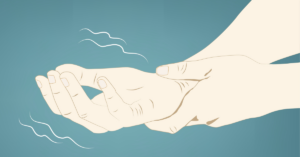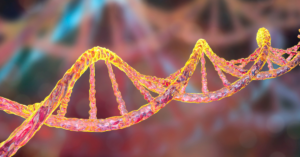
The cortex has many folds, just like how an origami flower has many folds. This helps increase the brain surface area by tightly packing in neurons. “Origami Lotus Flowers” by Dominic’s pics is licensed under CC BY 2.0.
The cerebral cortex, also called “the cortex,” is a highly organized layer of tissue that forms the outer surface of the mammalian brain. Many of the brain’s most sophisticated functions relating to senses, movement, language, attention, and decision-making happen within the cortex.
In many mammals, the cortex is characterized by a distinctive pattern of folds, like an origami flower. These folds are made of bumps called gyri and grooves called sulci; these naturally occur where the origami paper is folded to give its distinctive flower shape. These folds dramatically increase the brain’s surface area. Think about how large the origami paper is when you unfold the flower; the human brain does the same thing to make space for around 16 billion tightly packed neurons. The cortex is divided lengthwise into two hemispheres, joined by a thick bundle of nerve fibers. Each hemisphere is divided by prominent sulci and gyri into four lobes—the frontal, parietal, temporal, and occipital. Each of these four lobes is responsible for carrying out different tasks and communicating with other areas of the brain and the body.
What is the Purpose of the Four Lobes?
Most brain functions require high levels of coordination between multiple brain regions to guide you through everyday tasks, with each area being responsible for certain activities. For example, within the cortex, movement is primarily controlled by the frontal lobe, certain forms of sensory information are processed in the parietal lobe, auditory processing occurs in the temporal lobe, and visual processing occurs in the occipital lobe. The frontal and parietal lobes will be the focus of the following sections, as these areas are more impacted by spinocerebellar ataxias (SCAs) than other area of the cortex.
The Frontal Lobe
Motor control and executive function are two of the main processes the frontal lobe is responsible for. Executive function is a term for the higher-level understanding that are required to plan, focus, and multitask. Unfortunately, executive dysfunction is common in individuals with SCA, particularly when it comes to planning and working memory. The primary motor cortex (PMC) sits within the frontal lobe and controls voluntary movements. Each part of the body is controlled by a particular collection of neurons in the PMC. Some of the more recognizable symptoms of SCA happen because of neuronal degeneration of the PMC or the network it uses to communicate with other brain regions. Patients with SCA usually struggle with fine motor skills and walking.
The Parietal Lobe
One of the most important roles of the parietal lobe is understanding where you are in a three-dimensional space. The parietal lobe collects inputs from your touch sensations, like temperature, pressure, and pain, to develop self-perception. This idea of self-perception is how you understand where things are around you. Patients with SCA typically experience poor coordination, depth perception, navigation or orientation, and visuospatial organization (such as relating objects to each other or to yourself).
The Cerebral Cortex and SCA
Although the cerebellum is the main structure affected by SCA, the disease also affects other brain areas. This includes the cerebral cortex and the pathways that connect the cortex to the cerebellum, which can also be impacted to varying degrees. There is still a lot we don’t know about the cerebral cortex in SCAs, since a lot of research has focused on the cerebellum. However, there are ongoing research studies to help to understand how neurodegeneration in SCA affects the cerebral cortex and how the brain adapts to these differences. For example, a group of researchers at the Moss Rehabilitation Research Institute are investigating how the cortex helps or hinders ataxia patients from learning new kinds of movement. Understanding these processes could guide the development of improved therapies.
If you would like to learn more about Cerebral Cortex, take a look at these resources by the Cleveland Clinic and Physiopedia.
Snapshot Written by: Kaitlyn Neuman
Edited by: Dr. Celeste Suart

Snapshot: What is Tremor?
If you’ve ever felt shaky when speaking in public or after drinking too much coffee, then you’ve likely experienced tremor. Tremor is an involuntary, rhythmic shaking of parts of the Read More…


Snapshot: What is Dystonia?
Dystonia is a disorder that affects the way a person moves. Specifically, people with dystonia have involuntary muscle contractions, which can cause abnormal twisting postures. Dystonia can affect muscles anywhere Read More…


Snapshot: What Does Incomplete Penetrance Mean?
Incomplete penetrance is a characteristic of a wide range of genetic diseases, including hereditary forms of neurodegenerative disease, heart disease, and cancer. In short, it means that individuals carrying a Read More…









